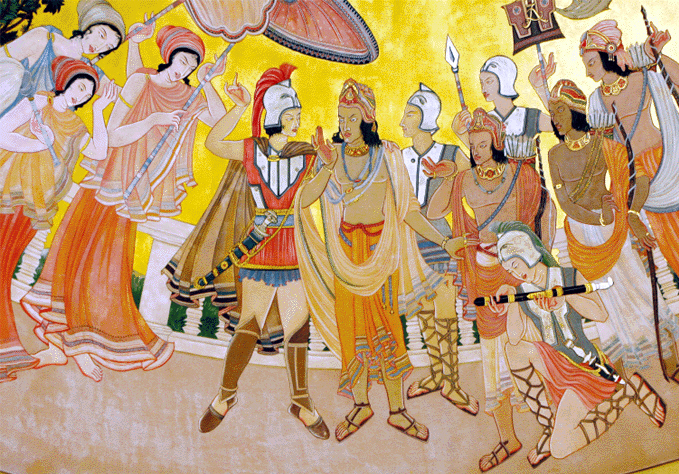
|
|
|
|
BY: SUN STAFF

King Porus of Paurava in the Punjab meets Alexander the Great Nov 20, 2013 — CANADA (SUN) — King Porus was the King of Paurava, an ancient state within the territory of modern day Punjab. The name 'Porus' is a Greek derivation of the Sanskrit 'Puru', or 'Purushottama'. The kingdom of Paurava was located between the Jhelum River and the Chenab River (in Greek, the Hydaspes and Acesines Rivers) in modern day Punjab, Pakistan, and later of dominions extending to the Beas (Gk. the Hyphasis). King Porus famously fought Alexander the Great in the Battle of the Hydaspes River (modern day Mong) in 326 B.C., where he met his defeat. Porus then served Alexander as a client king.
The mural shown here, painted c. 1930 in the dome of the India House at Aldwych in London, depicts the scene after the battle, when Alexander was so impressed by Porus' kingly bearing that he returned his kingdom to him, and deputed him as client king. Alexander then made a hasty departure from the Punjab, and King Porus was established as sovereign for the West Punjab until his death. Some historians blame a conspiracy by Chanakya Pandit for the poisoning of Porus. His son reigned for a short period and was eventually succeeded by Chandragupta Maurya.

The Rig Veda mentions the Puru as one of the ancient Vedic tribes, and King Porus is believed to be a descendent. The Paurava kingdom has existed since 1500 B.C., when King Sudas of the Pauravas defeated ten other kingdoms during the Battle of the Ten Kings. Paurava was also one of the kingdoms that fought in the Kurukshetra War. The Battle of the Ten Kings (dāśarājñá), is referenced in Mandala 7 of the Rig Veda (hymns 18, 33 and 83.4-8). It has been described as an "internecine war" fought by the Vedic people (Aryans), (according to the 1911 Britannica), and also as a battle between the Aryans and the Dasyus. It took place as Puru tribes, allied with other tribes of the Punjab and guided by the royal sage Vishvamitra, opposed the Trtsu (Bharata) king Sudas in battle. This is memorialized by the poet Sudas and priest Vasistha in Rig Veda 7.18. When Alexander invaded India in 326 B.C., the Paurava kingdom was divided, with King Porus controlling the western region (roughly equivalent to the Pakistani Punjab), while the powerful Nanda Empire from the east (around Bihar and Bengal) controlled the eastern portion (roughly equivalent to the Indian Punjab). Alexander conquered the western portion of Paurava, but his men refused to challenge the powerful Nanda Empire further east. Since his men had such a hard time fighting Porus' smaller army, the prospect of facing the much larger Nanda army, and especially their famed war elephants, deflated the morale of Alexander's army. 
King Porus fighting Alexander at the Battle of the Hydaspes River According to Buddha Prakash, a professor at the Institute of Indic Studies, the Purus "settled between the Asikni and the Parusni, whence they launched their onslaught on the Bharatas, and after the initial rebuff in the Dasarajna War, soon regrouped and resumed their march on the Yamuna and the Sarasvati and subsequently merged with the Bharatas. Some of their off-shoots lingered on in the Punjab and one of their scions played a notable part in the events of the time at Alexander's invitation. They probably survived in the Punjab under the name of Puri, which is a sub-caste of the Kshatriyas." Some scholars believe that Porus was Shoorsaini, and that his vanguard soldiers carried the banner of Herakles, whom Megasthenes (who travelled to India after Porus had been supplanted by Chandragupta) explicitly identified with the Shoorsainis of Mathura. This Herakles of Megasthenes and Arrian is identified by many scholars as being Lord Krishna, and by others as being His elder brother Baladeva, who were both the ancestors and patron Deities of the Shoorsainis. 
Surrender of Porus to the Vasileos (king) Alexander The Harikulas have been identified by some scholars as being none other than the descendants of Yadu, and the Puru dynasty is generally understood to be that of the Pandava line. Some of the Shoorsainis are said to have migrated westwards to Punjab and modern Afghanistan from Mathura and Dvaraka, after Krishna's departure, where they established new kingdoms. The capital of Porus, located between the rivers Jhellum and Chenab in Punjab, was also home to the Punjabi Khatri or Kshatriyas. A gotra or subcaste of the Punjabi Khatris are called "Puri" after the king. Most of the Puris living today are Hindus or Sikhs who migrated to various parts of India after the partition in 1947. 
Alexander and Porus The Paurava kingdom ceased to exist once the entire kingdom was conquered by Chandragupta Maurya in 322 B.C. Chandragupta went on to conquer almost the whole of Southern Asia and parts of eastern Persia after he defeated Seleucus Nicator (who re-conquered most of Alexander's empire). Chandragupta's grandson, Ashoka the Great, was responsible for spreading Buddhism across the ancient world. Sources: Asiafinest.com, Wiki
| |